High-Resolution Estimation of Soil Saturated Hydraulic Conductivity via Upscaling and Karhunen–Loève Expansion within DREAM(ZS)
Abstract
1. Introduction
2. Methodologies
2.1. Soil Water Flow Modeling
2.2. Upscaling Method
2.3. KL Expansion
2.4. Bayesian Inference with
3. Setup for Downscaling Simulations
3.1. Parameter Settings for Soil Profiles
3.2. Settings for the Fine- and Coarse- Scale Grids
3.3. Settings for the Observations
4. Simulation Results and Discussions
4.1. Presentation of Case Results
4.2. Effects of the Coarse- and Fine-Scale Grid Ratios
4.3. Effects of the Spatial Distribution of the Field
4.4. Impact of Observation Site Density
5. Conclusions
Author Contributions
Funding
Institutional Review Board Statement
Informed Consent Statement
Data Availability Statement
Acknowledgments
Conflicts of Interest
References
- Rallo, G.; Provenzano, G.; Castellini, M.; Sirera, À.P. Application of EMI and FDR sensors to assess the fraction of transpirable soil water over an olive grove. Water 2018, 10, 168. [Google Scholar] [CrossRef]
- Sanayei, H.R.Z.; Talebdokhti, N.; Rakhshandehroo, G.R. Analytical solutions for water infiltration into unsaturated–semi-saturated soils under different water content distributions on the top boundary. Iran. J. Sci. Technol. Trans. Civ. Eng. 2019, 43, 747–760. [Google Scholar] [CrossRef]
- Liu, S.; Fan, M.; Lu, D. Uncertainty quantification of the convolutional neural networks on permeability estimation from micro-CT scanned sandstone and carbonate rock images. Geoenergy Sci. Eng. 2023, 230, 212160. [Google Scholar] [CrossRef]
- Savvides, A.A.; Papadrakakis, M. Uncertainty Quantification of Failure of Shallow Foundation on Clayey Soils with a Modified Cam-Clay Yield Criterion and Stochastic FEM. Geotechnics 2022, 2, 348–384. [Google Scholar] [CrossRef]
- Hmimou, A.; Maslouhi, A.; Tamoh, K.; Candela, L. Experimental monitoring and numerical study of pesticide (carbofuran) transfer in an agricultural soil at a field site. Comptes Rendus Geosci. 2014, 346, 255–261. [Google Scholar] [CrossRef]
- Qanza, H.; Maslouhi, A.; Hachimi, M.; Hmimou, A. Inverse estimation of the hydrodispersive properties Of unsaturated soil using complex-variable-differentiation method under field experiments conditions. Eurasian Soil Sci. 2018, 51, 1229–1239. [Google Scholar] [CrossRef]
- Rezaei, M.; Seuntjens, P.; Joris, I.; Boënne, W.; Van Hoey, S.; Campling, P.; Cornelis, W. Sensitivity of water stress in a two-layered sandy grassland soil to variations in groundwater depth and soil hydraulic parameters. Hydrol. Earth Syst. Sci. 2016, 20, 487–503. [Google Scholar] [CrossRef]
- Qanza, H.; Maslouhi, A.; Abboudi, S. Experience of inverse modeling for estimating hydraulic parameters of unsaturated soils. Russ. Meteorol. Hydrol. 2016, 41, 779–788. [Google Scholar] [CrossRef]
- Lin, Q.; Xu, S. Parameter identification and uncertainty analysis of soil water movement model in field layered soils based on Bayes Theory. J. Hydraul. Eng. 2018, 49, 428–438. [Google Scholar] [CrossRef]
- Yu, M.; Zhang, K. Identification of soil hydraulic parameters based on HYDRUS-2D software and simulation of soil water movement under indirect subsurface drip irrigation. Acta Agric. Zhejiangensis 2019, 31, 458–468. [Google Scholar] [CrossRef]
- Brunetti, G.; Šimůnek, J.; Bogena, H.; Baatz, R.; Huisman, J.A.; Dahlke, H.; Vereecken, H. On the information content of cosmic-ray neutron data in the inverse estimation of soil hydraulic properties. Vadose Zone J. 2019, 18, 1–24. [Google Scholar] [CrossRef]
- Mustapha, H.; Abdellatif, M.; Karim, T.; Hamid, Q. Estimation of soil hydraulic properties of basin Loukkos (Morocco) by inverse modeling. KSCE J. Civ. Eng. 2019, 23, 1407–1419. [Google Scholar] [CrossRef]
- Pan, M.; Huang, Q.; Feng, R.; Huang, G. Estimation of water and heat transfer parameters of saturated silica sand by using different types of data. Trans. Chin. Soc. Agric. Eng. 2020, 36, 75–82. [Google Scholar] [CrossRef]
- Zhao, Z.; Illman, W.A. Improved high-resolution characterization of hydraulic conductivity through inverse modeling of HPT profiles and steady-state hydraulic tomography: Field and synthetic studies. J. Hydrol. 2022, 612, 128124. [Google Scholar] [CrossRef]
- Bandai, T.; Ghezzehei, T.A. Forward and inverse modeling of water flow in unsaturated soils with discontinuous hydraulic conductivities using physics-informed neural networks with domain decomposition. Hydrol. Earth Syst. Sci. 2022, 26, 4469–4495. [Google Scholar] [CrossRef]
- Singh, U.; Sharma, P.K. Comparison of saturated hydraulic conductivity estimated by surface NMR and empirical equations. J. Hydrol. 2023, 617, 128929. [Google Scholar] [CrossRef]
- Vrugt, J.A.; Ter Braak, C.J.; Clark, M.P.; Hyman, J.M.; Robinson, B.A. Treatment of input uncertainty in hydrologic modeling: Doing hydrology backward with Markov chain Monte Carlo simulation. Water Resour. Res. 2008, 44. [Google Scholar] [CrossRef]
- Vrugt, J.A.; ter Braak, C.J.; Diks, C.G.; Robinson, B.A.; Hyman, J.M.; Higdon, D. Accelerating Markov chain Monte Carlo simulation by differential evolution with self-adaptive randomized subspace sampling. Int. J. Nonlinear Sci. Numer. Simul. 2009, 10, 273–290. [Google Scholar] [CrossRef]
- Laloy, E.; Vrugt, J.A. High-dimensional posterior exploration of hydrologic models using multiple-try DREAM (ZS) and high-performance computing. Water Resour. Res. 2012, 48. [Google Scholar] [CrossRef]
- Vrugt, J.A. Markov chain Monte Carlo simulation using the DREAM software package: Theory, concepts, and MATLAB implementation. Environ. Model. Softw. 2016, 75, 273–316. [Google Scholar] [CrossRef]
- Jiang, S.; Jomaa, S.; Büttner, O.; Meon, G.; Rode, M. Multi-site identification of a distributed hydrological nitrogen model using Bayesian uncertainty analysis. J. Hydrol. 2015, 529, 940–950. [Google Scholar] [CrossRef]
- Jiang, S.; Yuan, L.; Zhang, X.; Huang, J.; Zhou, C. Stochastic back analysis and comparison of spatially varying geotechnical mechanical parameters based on limited data. Chin. J. Rock Mech. Eng. 2020, 39, 1265–1276. [Google Scholar] [CrossRef]
- Morandage, S.; Laloy, E.; Schnepf, A.; Vereecken, H.; Vanderborght, J. Bayesian inference of root architectural model parameters from synthetic field data. Plant Soil 2021, 467, 67–89. [Google Scholar] [CrossRef]
- Liu, Y.; Fernández-Ortega, J.; Mudarra, M.; Hartmann, A. Pitfalls and a feasible solution for using KGE as an informal likelihood function in MCMC methods: DREAM (ZS) as an example. Hydrol. Earth Syst. Sci. 2022, 26, 5341–5355. [Google Scholar] [CrossRef]
- Guo, Q.; Wu, W. Application of parameter optimization methods based on Kalman formula to the soil–crop system model. Int. J. Environ. Res. Public Health 2023, 20, 4567. [Google Scholar] [CrossRef] [PubMed]
- Li, N.; Yue, X.; Ren, L. Numerical homogenization of the Richards equation for unsaturated water flow through heterogeneous soils. Water Resour. Res. 2016, 52, 8500–8525. [Google Scholar] [CrossRef]
- Zhu, J.; Mohanty, B.P. Spatial averaging of van Genuchten hydraulic parameters for steady-state flow in heterogeneous soils: A numerical study. Vadose Zone J. 2002, 1, 261–272. [Google Scholar] [CrossRef]
- Zhu, J.; Mohanty, B.P. Effective hydraulic parameters for steady state vertical flow in heterogeneous soils. Water Resour. Res. 2003, 39. [Google Scholar] [CrossRef]
- Zhu, J.; Mohanty, B. Upscaling of hydraulic properties of heterogeneous soils. In Scaling Methods in Soil Physics; Routledge: Abingdon, UK, 2003; pp. 97–118. [Google Scholar] [CrossRef]
- Roth, K.; Vogel, H.; Kasteel, R. The scaleway: A conceptual framework for upscaling soil properties. In Modelling of Transport Processes in Soils; Wageningen Pers: Wageningen, The Netherlands, 1999; pp. 477–490. Available online: https://citeseerx.ist.psu.edu/document?repid=rep1&type=pdf&doi=4653aa13563ead62a92b8a9d0dc56dcea32b232d (accessed on 15 May 2024).
- Vogel, H.J.; Roth, K. Moving through scales of flow and transport in soil. J. Hydrol. 2003, 272, 95–106. [Google Scholar] [CrossRef]
- Li, N.; Yue, X.; Wang, W.; Ma, Z. Inverse estimation of spatiotemporal flux boundary conditions in unsaturated water flow modeling. Water Resour. Res. 2021, 57, e2020WR028030. [Google Scholar] [CrossRef]
- Comunian, A.; Giudici, M. Hybrid inversion method to estimate hydraulic transmissivity by combining multiple-point statistics and a direct inversion method. Math. Geosci. 2018, 50, 147–167. [Google Scholar] [CrossRef]
- Lan, T.; Shi, X.; Jiang, B.; Sun, Y.; Wu, J. Joint inversion of physical and geochemical parameters in groundwater models by sequential ensemble-based optimal design. Stoch. Environ. Res. Risk Assess. 2018, 32, 1919–1937. [Google Scholar] [CrossRef]
- Wuwen, Q.; Junrui, C.; Yuan, Q.; Zengguang, X. Simulation-optimization model for estimating hydraulic conductivity: A numerical case study of the Lu Dila hydropower station in China. Hydrogeol. J. 2019, 27, 2595–2616. [Google Scholar] [CrossRef]
- Uribe, F.; Papaioannou, I.; Betz, W.; Straub, D. Bayesian inference of random fields represented with the Karhunen–Loève expansion. Comput. Methods Appl. Mech. Eng. 2020, 358, 112632. [Google Scholar] [CrossRef]
- Blaheta, R.; Béreš, M.; Domesová, S.; Horák, D. Bayesian inversion for steady flow in fractured porous media with contact on fractures and hydro-mechanical coupling. Comput. Geosci. 2020, 24, 1911–1932. [Google Scholar] [CrossRef]
- Gu, X.; Wang, L.; Ou, Q.; Zhang, W.; Sun, G. Reliability assessment of rainfall-induced slope stability using Chebyshev-Galerkin-KL expansion and Bayesian approach. Can. Geotech. J. 2023, 60, 1909–1922. [Google Scholar] [CrossRef]
- Mualem, Y. A new model for predicting the hydraulic conductivity of unsaturated porous media. Water Resour. Res. 1976, 12, 513–522. [Google Scholar] [CrossRef]
- Van Genuchten, M.T. A closed-form equation for predicting the hydraulic conductivity of unsaturated soils. Soil Sci. Soc. Am. J. 1980, 44, 892–898. [Google Scholar] [CrossRef]
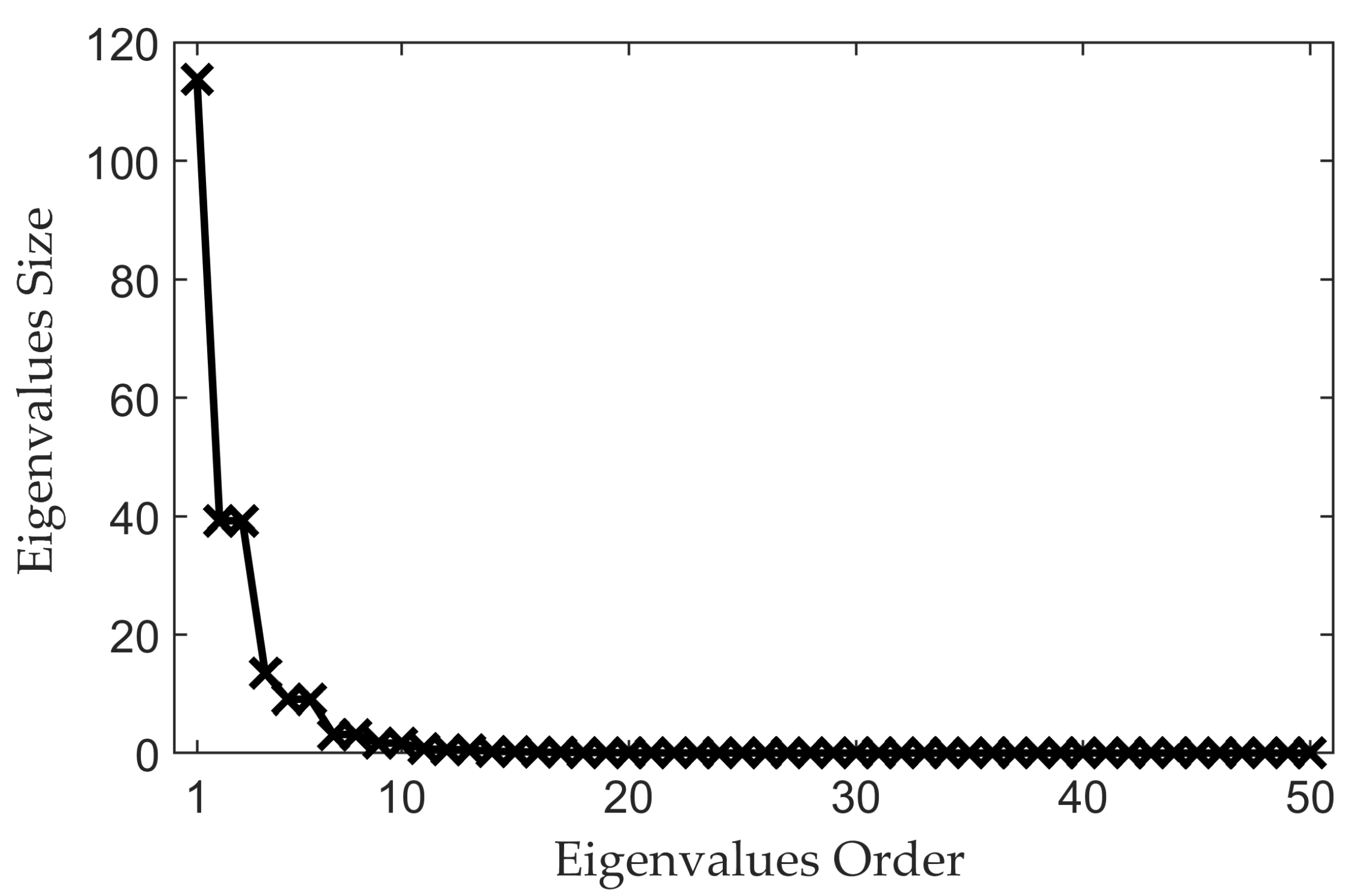
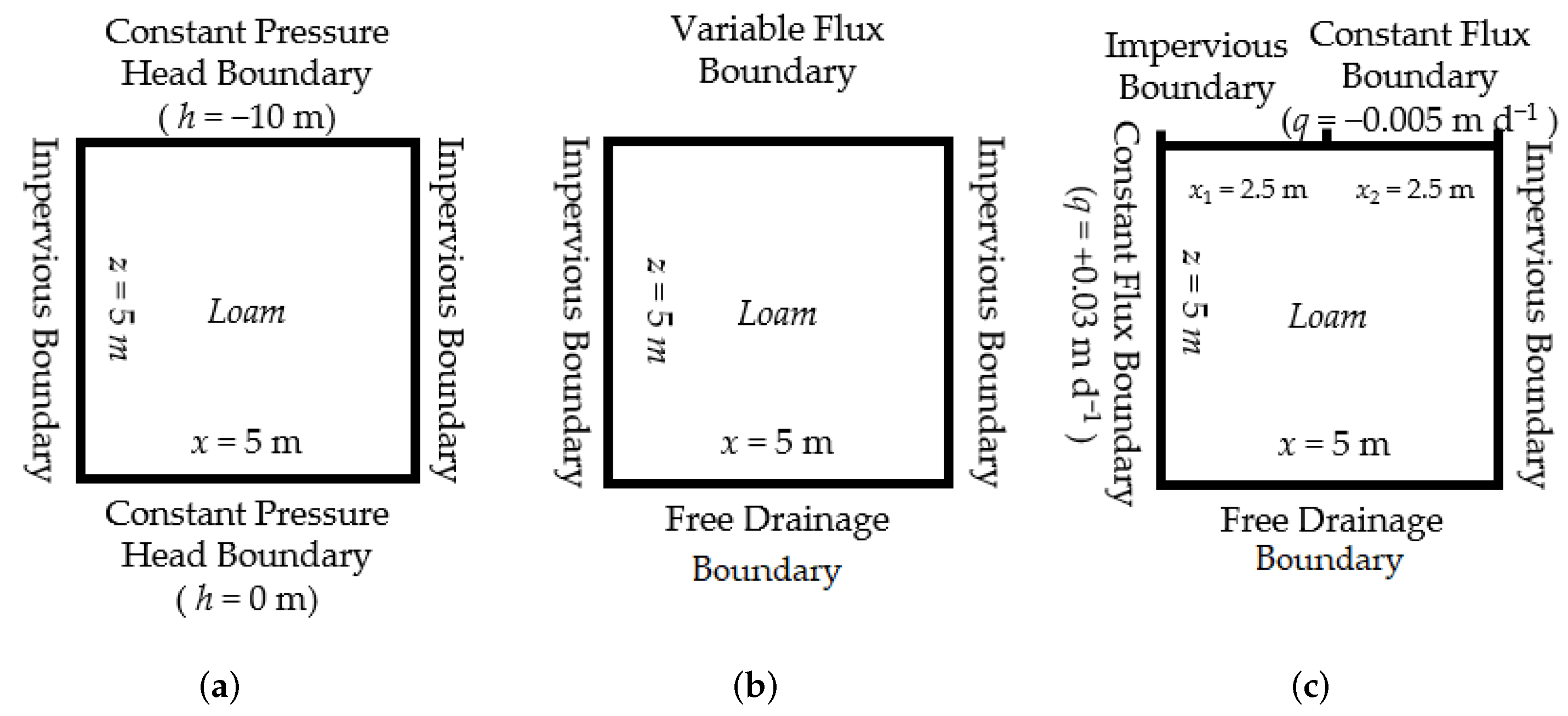

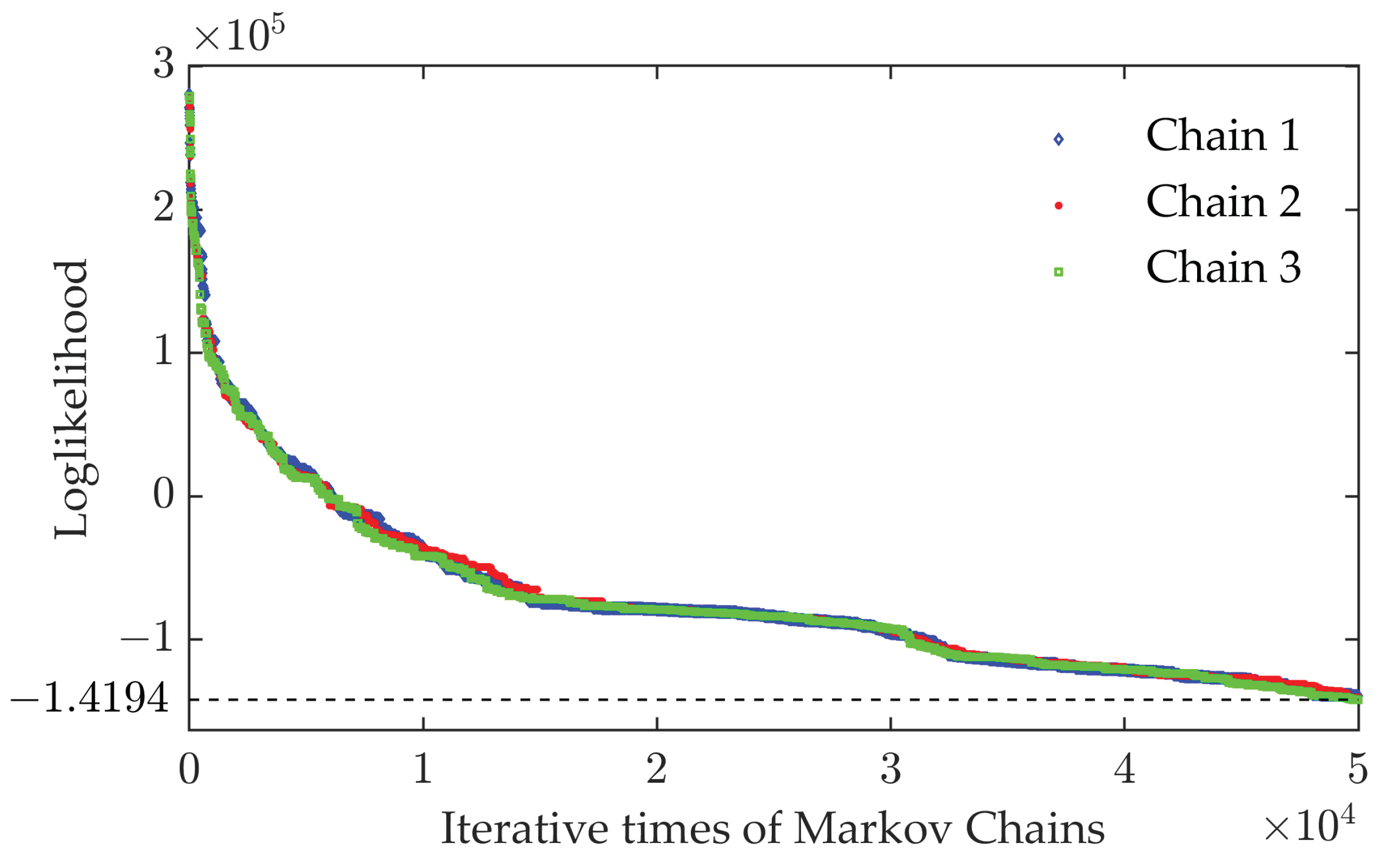
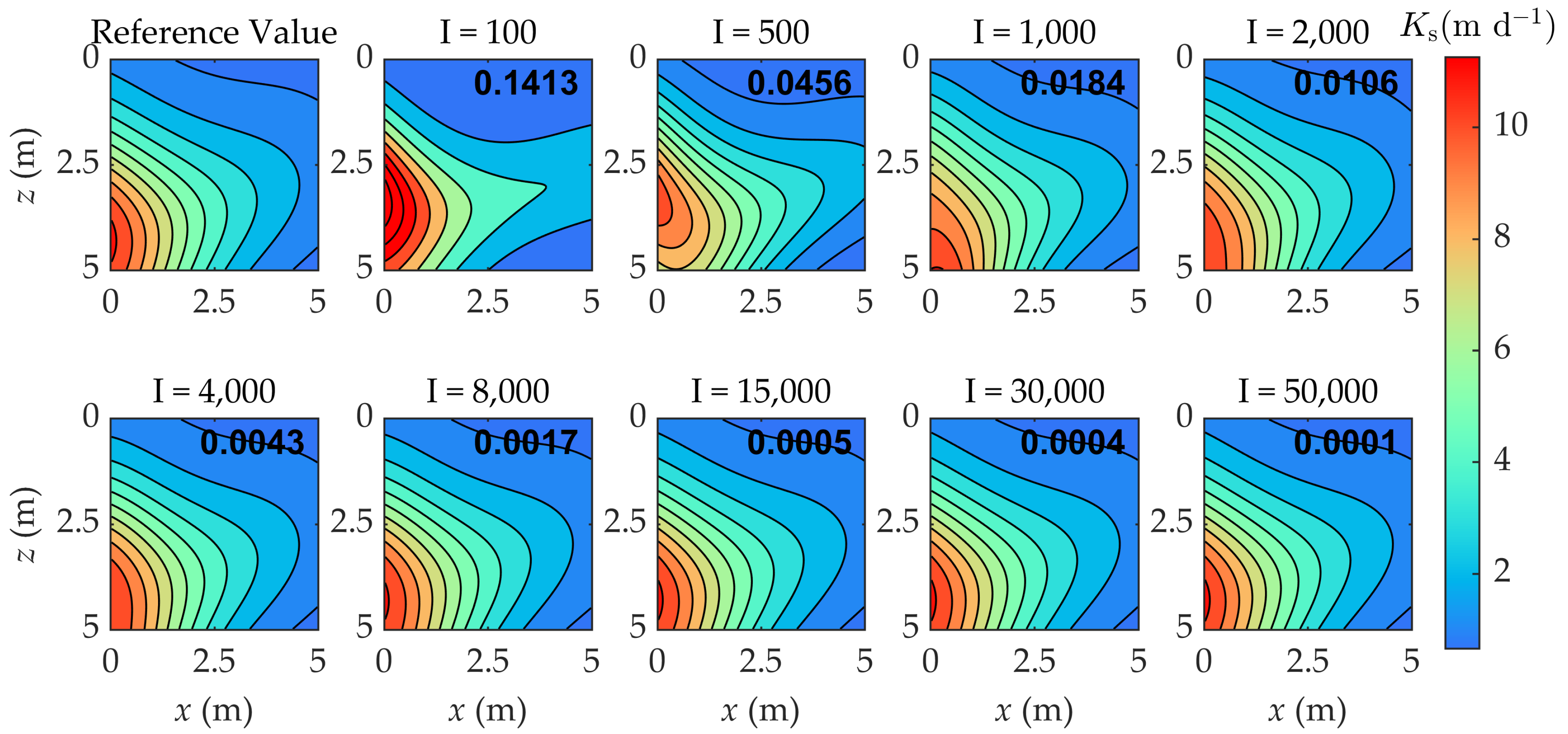
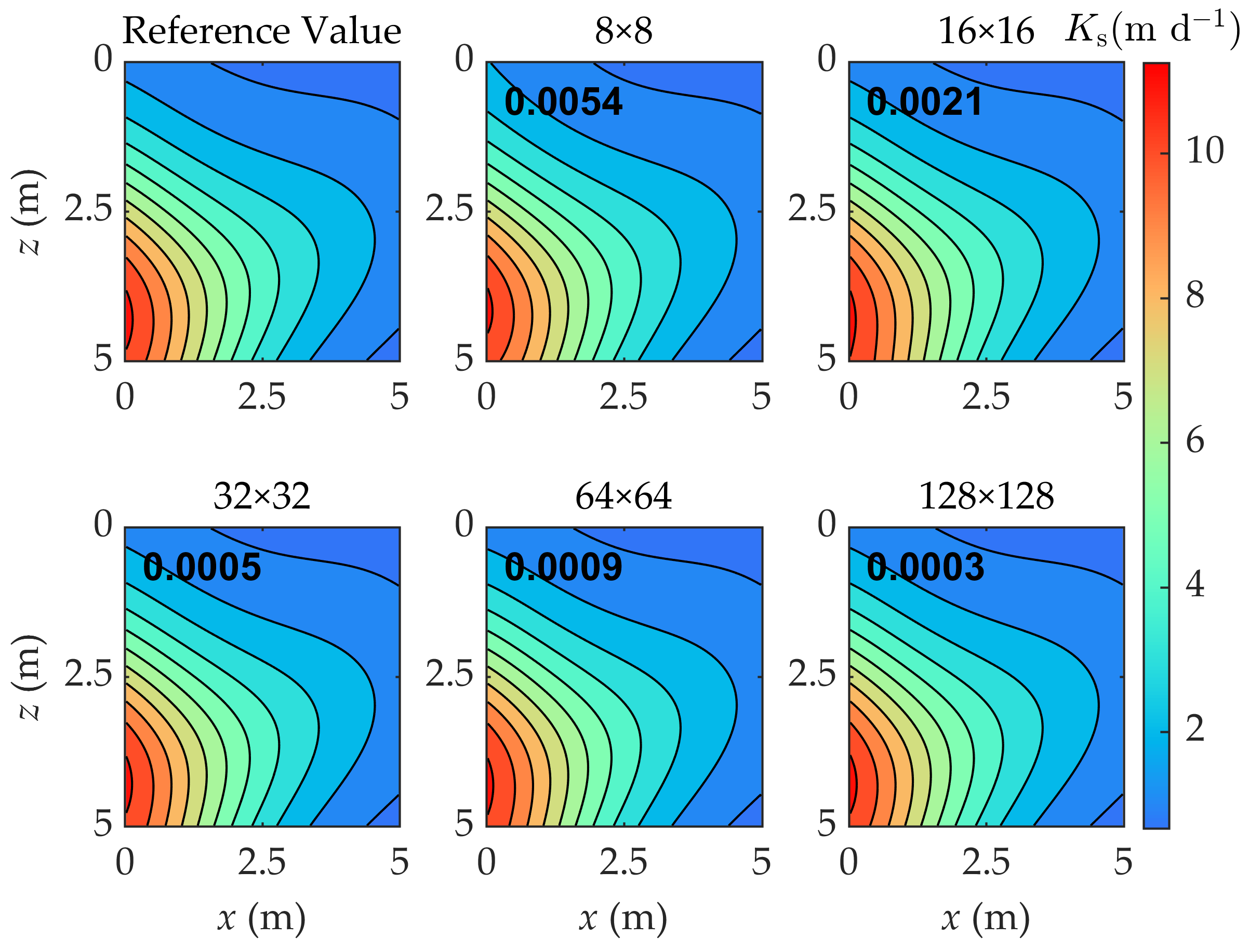



| Scale | Simulation Time (min) | -NRMSE |
|---|---|---|
| 8 × 8 | 59 | 0.0054 |
| 16 × 16 | 89 | 0.0021 |
| 32 × 32 | 178 | 0.0005 |
| 64 × 64 | 534 | 0.0009 |
| 128 × 128 (fine-scale) | 1067 | 0.0003 |
| Model | Scale Size (NRMSE) | ||||
|---|---|---|---|---|---|
| 8 × 8 | 16 × 16 | 32 × 32 | 64 × 64 | 128 × 128 | |
| A | 0.0054 | 0.0021 | 0.0005 | 0.0009 | 0.0003 |
| B | 0.0640 | 0.0174 | 0.0023 | 0.0005 | 0.0002 |
| C | 0.0317 | 0.0988 | 0.0452 | 0.0334 | 0.0431 |
| Model | Number of Observation Points (NRMSE) | ||||||||
|---|---|---|---|---|---|---|---|---|---|
| = 0.5 | = 1.2 | = 2.0 | = 8 | = 16 | = 32 | = 4 | = 16 | = 45 | |
| A | 0.0006 | 0.0539 | 0.0008 | 0.0008 | 0.0447 | 0.1372 | 0.0005 | 0.0001 | 3.20 × 10−5 |
| B | 0.0024 | 0.0008 | 0.0095 | 4.85 | 1.19 | 2.95 | 0.0001 | 1.05 | 2.51 |
| C | 0.0785 | 0.0056 | 0.0092 | 0.0084 | 0.0010 | 0.0006 | 0.0393 | 0.0296 | 0.0165 |
| Model | Spatial Distribution of Field (NRMSE) | |||||||
|---|---|---|---|---|---|---|---|---|
| = 974 | = 424 | = 124 | = 74 | = 24 | = 14 | = 9 | = 4 | |
| A | 0.0009 | 0.0003 | 0.0007 | 0.0008 | 0.0029 | 0.0094 | 0.0157 | 0.0179 |
| B | 0.0058 | 0.0045 | 0.0029 | 0.0031 | 0.0017 | 0.0037 | 0.0026 | 0.0313 |
| C | 0.0169 | 0.0244 | 0.0445 | 0.0882 | 0.0763 | 0.0105 | 0.0079 | 0.0178 |
Disclaimer/Publisher’s Note: The statements, opinions and data contained in all publications are solely those of the individual author(s) and contributor(s) and not of MDPI and/or the editor(s). MDPI and/or the editor(s) disclaim responsibility for any injury to people or property resulting from any ideas, methods, instructions or products referred to in the content. |
© 2024 by the authors. Licensee MDPI, Basel, Switzerland. This article is an open access article distributed under the terms and conditions of the Creative Commons Attribution (CC BY) license (https://creativecommons.org/licenses/by/4.0/).
Share and Cite
Xia, Y.; Li, N. High-Resolution Estimation of Soil Saturated Hydraulic Conductivity via Upscaling and Karhunen–Loève Expansion within DREAM(ZS). Appl. Sci. 2024, 14, 4521. https://doi.org/10.3390/app14114521
Xia Y, Li N. High-Resolution Estimation of Soil Saturated Hydraulic Conductivity via Upscaling and Karhunen–Loève Expansion within DREAM(ZS). Applied Sciences. 2024; 14(11):4521. https://doi.org/10.3390/app14114521
Chicago/Turabian StyleXia, Yang, and Na Li. 2024. "High-Resolution Estimation of Soil Saturated Hydraulic Conductivity via Upscaling and Karhunen–Loève Expansion within DREAM(ZS)" Applied Sciences 14, no. 11: 4521. https://doi.org/10.3390/app14114521
APA StyleXia, Y., & Li, N. (2024). High-Resolution Estimation of Soil Saturated Hydraulic Conductivity via Upscaling and Karhunen–Loève Expansion within DREAM(ZS). Applied Sciences, 14(11), 4521. https://doi.org/10.3390/app14114521








